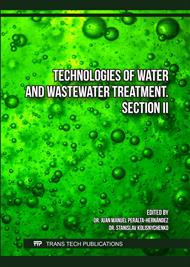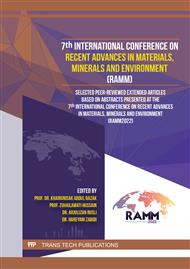[1]
H. Awab, P. T. T. Paramalinggam, and A. R. Mohd Yusoff, "Characterization of Alum Sludge for Reuse and Disposal," Malaysian J. Fundam. Appl. Sci., vol. 8, no. 4, p.251–255, 2012.
DOI: 10.11113/mjfas.v8n4.160
Google Scholar
[2]
T. Ahmad, K. Ahmad, and M. Alam, "Characterization of Water Treatment Plant's Sludge and its Safe Disposal Options," Procedia Environ. Sci., vol. 35, p.950–955, 2016.
DOI: 10.1016/j.proenv.2016.07.088
Google Scholar
[3]
T. Y. Ooi et al., "Optimization of aluminium recovery from water treatment sludge using Response Surface Methodology," J. Environ. Manage., vol. 228, no. August, p.13–19, 2018.
DOI: 10.1016/j.jenvman.2018.09.008
Google Scholar
[4]
F. Sun, W. Hu, H. Pei, X. Li, X. Xu, and C. Ma, "Evaluation on the dewatering process of cyanobacteria-containing AlCl3 and PACl drinking water sludge," Sep. Purif. Technol., vol. 150, p.52–62, 2015.
DOI: 10.1016/j.seppur.2015.06.030
Google Scholar
[5]
E. Q. A. EQA, "Federal Subsidiary Legislation Environmental Quality Act 1974 [ Act 127 ]," Minist. Nat. Resour. Environ., no. July 1977, p.2–6, 2004.
Google Scholar
[6]
Z. hai He et al., "Recycling hazardous water treatment sludge in cement-based construction materials: Mechanical properties, drying shrinkage, and nano-scale characteristics," J. Clean. Prod., vol. 290, p.125832, 2021.
DOI: 10.1016/j.jclepro.2021.125832
Google Scholar
[7]
S. De Carvalho Gomes, J. L. Zhou, W. Li, and G. Long, "Progress in manufacture and properties of construction materials incorporating water treatment sludge: A review," Resour. Conserv. Recycl., vol. 145, no. December 2018, p.148–159, 2019.
DOI: 10.1016/j.resconrec.2019.02.032
Google Scholar
[8]
C. Exley, "Darwin, natural selection and the biological essentiality of aluminium and silicon," Trends Biochem. Sci., vol. 34, no. 12, p.589–593, 2009.
DOI: 10.1016/j.tibs.2009.07.006
Google Scholar
[9]
L. P. Rodrigues, J. Nilson, and F. Holanda, "Recycling of Water Treatment Plant Waste for Production of Soil- Cement Bricks," Procedia Mater. Sci., vol. 8, p.197–202, 2015.
DOI: 10.1016/j.mspro.2015.04.064
Google Scholar
[10]
T. Yiew et al., "Optimization of aluminium recovery from water treatment sludge using Response Surface Methodology," J. Environ. Manage., vol. 228, no. January, p.13–19, 2018.
DOI: 10.1016/j.jenvman.2018.09.008
Google Scholar
[11]
L. Kumari, G. H. Du, W. Z. Li, R. S. Vennila, S. K. Saxena, and D. Z. Wang, "Synthesis , microstructure and optical characterization of zirconium oxide nanostructures," vol. 35, p.2401–2408, 2009.
DOI: 10.1016/j.ceramint.2009.02.007
Google Scholar
[12]
H. X. Zhang et al., "Crystal structure , corrosion kinetics of new zirconium alloys and residual stress analysis of oxide films," J. Nucl. Mater., vol. 396, no. 1, p.65–70, 2010.
DOI: 10.1016/j.jnucmat.2009.10.055
Google Scholar
[13]
T. Ahmad, K. Ahmad, and M. Alam, "Sustainable management of water treatment sludge through 3 ' R ' concept," J. Clean. Prod., vol. 124, p.1–13, 2016.
DOI: 10.1016/j.jclepro.2016.02.073
Google Scholar
[14]
O. A. Graeve, "Zirconia," p.169–197, 2008.
Google Scholar
[15]
H. Lin, C. Yin, and A. Mo, "Zirconia Based Dental Biomaterials : Structure , Mechanical Properties , Biocompatibility , Surface Modification , and Applications as Implant," vol. 2, no. August, p.1–7, 2021.
DOI: 10.3389/fdmed.2021.689198
Google Scholar
[16]
L. Yin, Y. Nakanishi, A. Alao, and X. Song, "A review of engineered zirconia surfaces in biomedical applications," Procedia CIRP, vol. 65, p.284–290, 2017.
DOI: 10.1016/j.procir.2017.04.057
Google Scholar
[17]
C. F. K. Murti, H. Aldila, Endarko, and Triwikantoro, "Particle size analysis of the synthesised zro2 from natural zircon sand with variation of ph deposition using alkali fusion-coprecipitation method," Mater. Sci. Forum, vol. 966 MSF, p.89–94, 2019.
DOI: 10.4028/www.scientific.net/MSF.966.89
Google Scholar




